Peanut, The World’s Ugliest Dog Gets a Makeover
Like the winners of the Miss America contest or the Nobel Prize, the pageantries and celebrations of the World’s Ugliest Dog did not end when he stepped off the stage.
The two-year-old Chihuahua-Shih Tzu mix named Peanut won the big trophy and the admiration of his peers at the Marin-Sonoma Fair in Petaluma, CA last week, but that was only the beginning of his journey.
Last night, Peanut and his owner Holly Chandler were guests on Jimmy Kimmel Live. Kimmel, who was familiar with the tough road that Peanut, a rescue dog and burn victim has traveled, wanted to make sure he could give the little dog an experience that he would not soon forget: a makeover.
Kimmel’s initial take on Peanut was that “he’s either the World’s Ugliest Dog or the World’s Prettiest Rat.”
In the montage, Peanut is put through all the essentials of a makeover: grooming, accessories and wardrobe. When Kimmel finally brings him on stage, dressed in a multicolored polka dot bowtie and his hair expertly combed, Peanut looks like a star.

He looks beautiful, doesn’t he?
There isn’t much you can change about Peanut to make him into a different dog. A bowtie and combing doesn’t change much about the pain and suffering this friendly dog went through to get to where he is.
A makeover is a nice gift, but truthfully Peanut should be proud to be who he is. You do you, Peanut. We love you just the way you are.
Peanut and his human live in Greenville, South Carolina. They entered Peanut in the contest in order to raise awareness around the subject of animal abuse.
10 Dogs Breeds That Love to Dig
Few of us cheer when our dog digs up our garden. However, we should keep in mind that if a dog has digging genes, in many cases we humans developed that natural trait to serve our purposes. It’s not the dog’s fault our objectives have changed.
While all dog breeds have some instinct to dig and may scratch or dig at the floor, carpet or bed, as he looks for the perfect spot, there is no doubt that some dogs take their digging a little more seriously than others.
See which dog breeds are most likely to dig and find out why they do it.
10 Dog Breeds Who Love to Dig
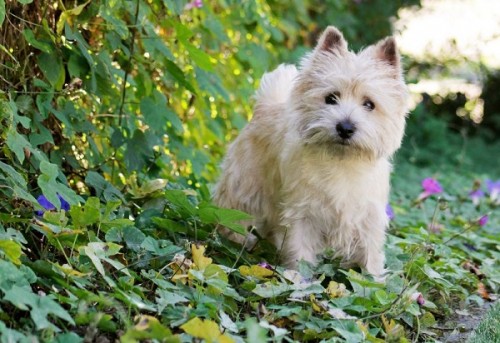
These dogs dig like it’s their job because at some point it probably was their job.
1. Dachshund
Hound Group. The German-bred Dachshund used his short but dogged legs to burrow deep into the earth, creating tunnels through which he hunted badgers and other prey. Today, the breed still follows his nose and instincts; he’s likely to dig up flower beds in an attempt to excavate the rodents in his yard. More About Dachshunds>>
2. Bedlington Terrier
Terrier Group. The Bedlington is a natural hunter with a penchant for pursuing rodents and vermin. The Bedlington may resemble a lamb in appearance, but the similarities end there. Tough and persistent, the powerhouse Belington digs with vigor to reach rabbits or rats. More About Bedlingtons>>
3. Cairn Terrier
Terrier Group. A small, active terrier native to Scotland’s Western Highlands, the Cairn was used in packs to control fur-bearing vermin. Like most terriers, Cairns tend to be diggers and are vigilant in their search for underground rodents. Did we mention the word terrier comes from Latin and means “earth dog?” More About Cairn Terriers>>
4. Beagle
Hound Group. Like many scent hounds, Beagles will dig in the yard for in-ground prey, but they may also dig out of the yard to follow the scent of above-ground prey. Bred for generations to track, a Beagle will take on any digging project to accomplish his mission. Although bred in England’s temperate climate, the breed also sometimes digs to cool off. Or perhaps that’s a smokescreen. Maybe the merry Beagle digs when there’s a shortage of rabbits to chase and a corresponding shortage of fun. More About Beagles>>
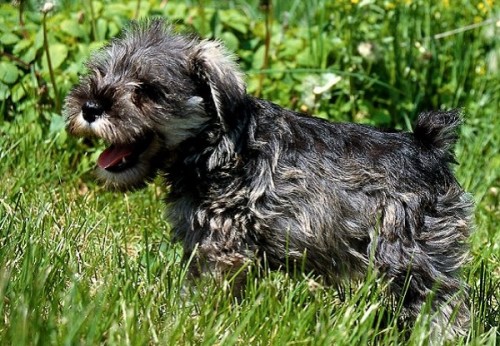
Terrier Group. Bred in Germany working on farms and pursuing vermin, the Miniature Schnauzer still rids its home and property of rats and mice today. The Schnauzer’s drive to exterminate rodents may drive him into the ground. The resulting dirt and holes are the downside. On the upside, unwanted visitors won’t be able to set up housekeeping in the family’s residence for long.
6. Wirehaired Pointing Griffon
Sporting Group. Though originally bred to be a tough hunter, the Wirehaired Pointing Griffon also may moonlight as a digger. His high energy level, drive to hunt, and desire for company make him an excellent sporting companion. In fact, he’s often called the “4-wheel drive of hunting dogs” because of his ability to excel on any kind of terrain: briars, underbrush, field, and water. With great talent, however, comes great responsibility (for the owner, at least!). If left without a task, the Griff may channel his 4-wheel drive skills into the ground.
Fair Weather Fans of Digging
It’s not a mater of whether or not these dogs like to dig, it’s simply a matter of weather.
7. Siberian Husky
Working group. Dogs bred in cold climates such as the Siberian Husky may dig for a warm, underground sleeping area during winter. But your garden isn’t safe in the springtime either; they also dig for cool spots when they’re hot. Their double coat offers insulation from both heat and cold, but who can blame them for supplementing what Mother Nature gave them.
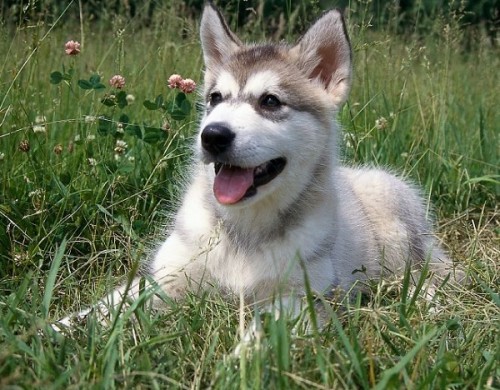
Working group. The Malamute is a legendary freighting dog of polar expeditions, to keep warm in the snow, they often dig to burrow themselves into a warmer underground sleeping arrangement. While the Malamute has adapted well to warm climates, they prefer the winter months and keeping their temperature pleasant, so it’s not uncommon to see them digging into the earth on a hot summer day to stay cool.
Dogs Who Weren’t Bred to Dig, But Might Do it Anyway
They aren’t professionals, but that won’t stop them from trying.
9. Australian Shepherd
Herding group. The Australian Shepherd wasn’t bred down under, but rather here in the United States. Nor was he bred specifically to dig. But he was bred to work all day alongside his owner. Developed to maintain high energy, an un-exercised Aussie may dig up gardens or under the fence in an effort to cultivate his own work and sense of fulfillment.
10. Border Collies
Herding group. Border Collies are high-energy dogs, having been bred to cover many miles a day in their native Scotland. Border Collies require and thrive on activity, so be prepared to keep them occupied and if you don’t, be prepared for them to occupy themselves. Border Collies are known for excelling at many jobs, if you give them a change they might add landscaper to their list.
Worst Dog Breeds for People With Allergies
Big Dogs
Saint Bernards, hounds and bulldogs are known for excessive drooling. If you’re allergic to dog saliva, avoid these breeds. German shepherds, Irish setters and English springer spaniels have lots of hair, which means more dander is produced and released into the air. Such dogs require regular baths and brushing, which allergic people should avoid.
Small Dogs
Some dogs are prone to allergies, like Boston terriers, Shih Tzus and Lhasa apsos, which means they may suffer dry skin, itchiness, watery eyes and extra mucous output; these allergy symptoms may stir up your own allergies. West Highland white terriers are prone to seborrhea, which causes their skin to renew quickly, increasing the dander produced. Dog breeds like the Pekingese and pug have skin folds that require regular care and produce dander.
Basic Tips
Avoid dogs who require frequent grooming, have double coats, are prone to allergies, have skin folds, are known droolers or produce excess dander.
Veterinary Eye Doctors Rally to Aid Assistance Dogs
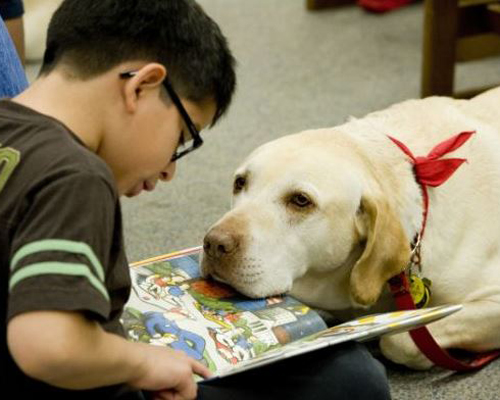
Free eye exams were given in May as part of an American College of Veterinary Ophthalmologists campaign designed to honor their public work. Nearly 29,000 service animals have been examined over the seven years of the National Service Animal Eye Exam Event, the ACVO reports.
Nearly all the patients examined this year were dogs employed as guide, handicapped assistance, detection, military, search and rescue, or registered therapy animals, but horses and a donkey were checked as well. Over 250 board-certified veterinary ophthalmologists participated in the event in the United States, Canada and Puerto Rico, looking for everything from eye redness, squinting and cloudy corneas to retinal disease, early cataracts and other abnormalities.
“Early detection and treatment are vital to these working animals,” says Stacee Daniel, executive director of the Meridian, Idaho-based ACVO. “Our hope is that by checking their vision early and often, we will be able to help a large number of service animals better assist their human friends.”
Success was measured not only by what the ophthalmologists did or didn’t find but also by the response of the animals’ owners. “Special thanks go out to the service animal owners who posted notes of gratitude on our Facebook page,” Daniel says. “Those kind words help our ophthalmologists and sponsors know that they made a positive impact, thus making them more likely to continue to participate in the future.”
Sponsors included Mount Laurel, N.J., drug compounder Stokes Pharmacy, medical device maker Welch Allyn Inc. of Skaneateles Falls, N.Y., and other industry partners. Exams are provided to active working animals certified by a formal training program or organization and those enrolled in a program.
How To Bathe a Dog: More Tips
Even though a good bath is one of the kindest things you can give your shelter’s dogs, chances are they’re not going to see it that way. But while you probably won’t win the hearts of all canines by getting them wet, you can make the experience more pleasant for both you and the dogs if you follow these steps. These instructions are appropriate for friendly shelter dogs in need of just a bit of cleaning. Heavily matted or aggressive dogs should be handled by a professional groomer.
1. Put on Your Wet Suit
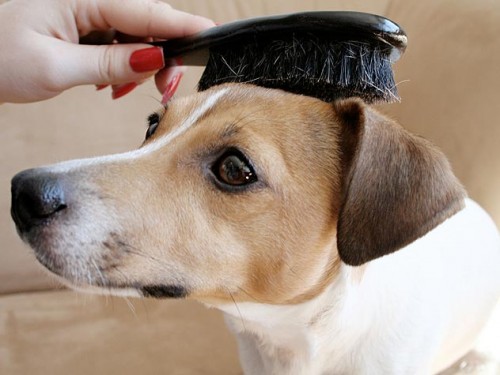
2. Prepare the Pooch
Before starting the bath, you may want to let the dog get accustomed to you, and give her a chance to relieve herself. If the animal is particularly nervous, consider muzzling her and asking a partner to help you. Try to comb out major snarls in the dog’s fur, and trim her nails to keep her from clawing you accidentally. Put a drop of mineral oil in each of the dog’s eyes and cotton balls in her ears to keep water and soap from getting in them. Be sure to remove the cotton balls after the bath!
3. Lather, Rinse, Repeat
If the dog is heavy, don a back brace. Then lift the dog into the tub. Use a lightweight spray hose that can be maneuvered with one hand. Test the water temperature before spraying the dog, then gently get the dog used to the temperature by spraying water on her back and shoulders. After the dog relaxes, begin washing her head and then move gradually toward her rear; this will prevent fleas from moving up her body and congregating on her head and face. Lather the animal with a mild shampoo formulated for dogs. The active ingredient should be chlorhexidine, which is mildly antiseptic. If you must use an insecticide, use a gentle pyrethrin-based shampoo, and be sure to follow the safety instructions on the bottle. Oatmeal shampoos are good for dogs with itchy skin.
4. Make Fluffy Fluffy
Scrub and rinse the dog thoroughly. Soap stays in the fur long after it seems to be gone, so keep rinsing. When you finish, rub the dog down thoroughly with towels. Don’t put a wet dog back in her cageit’s okay if she’s just damp, especially if you have a climate-controlled facility. If you use an automated dryer that hangs on the front of the cage, test the temperature of the air before aiming it toward the dog, and check on the animal at least every 15 minutes or so to make sure she’s comfortable.
5. Suds Up the Puppies
Puppies have special bathing needs. Don’t use an insecticidal shampoo on a puppy unless the shampoo is formulated specifically for puppies and the puppy actually has fleas. With a young dog, it’s especially important to use warm water and make his bathing experience pleasant, using just the right combination of gentleness and firmness. If you are kind and sensitive to their fears, puppies will begin to regard their baths with pleasure rather than dread, making life more pleasant for you, for the puppies, and eventually for their adoptive families.
Pup-tato Skins Recipe
Want to make any easy dog-treat that you and your dog can both enjoy? Try our easy recipe for Pup-tato Skins using only a couple of ingredients. Whether you are “tail”-gating, making Irish Nachos for St. Patrick’s Day or just looking for an easy treat to try, these dog-friendly spuds are sure to be a crowd-pleaser. As with any treat, feed in moderation, especially if it’s your first time feeding a particular snack.
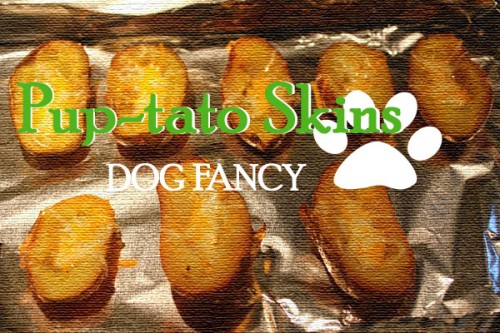
Fingerling or small yellow or red potatoes
You can also use full size russet potatoes, but you will need to cut them into smaller pieces.
Make sure they are an appropriate size for your dog so that they do not pose as a choking hazard.
Olive oil to lightly coat potatoes
Shredded cheese (1 tsp per potato)

Lightly coat potatoes with olive oil
Place potatoes on a lined sheet pan
Bake at 450 until fork-tender; about 45 min depending on the size of your potatoes
When potatoes are cool, cut in half lengthwise
Scoop out some of the potato to create a small well in your potato
Place potatoes back onto the baking sheet and sprinkle cheese into the well you have created
Bake again at 450 for 7-8 minutes or until cheese has melted

Best Dog Breeds for Swimming
One day as I watched my daughter’s Australian Shepherd, Cooper, and Labrador-mixed-breed, Kane, paddling in a lake, I noticed a rather significant variance in swimming form and style.
Kane’s webbed paws and strong legs moved him gracefully on the top of the water, his tail a remarkably effective rudder. Cooper, on the other hand, relied mainly on athleticism and determination. His paddling was powerful; his style was sub-par. But ever the herding dog, Cooper happily followed Kane back and forth in the water. As he grew tired, his “never give up” solution was to try to hitch a ride on Kane’s back. Thankfully Kane is as strong as an ox, and ridiculously tolerant about being his brother’s keeper, and/or his lifeboat.
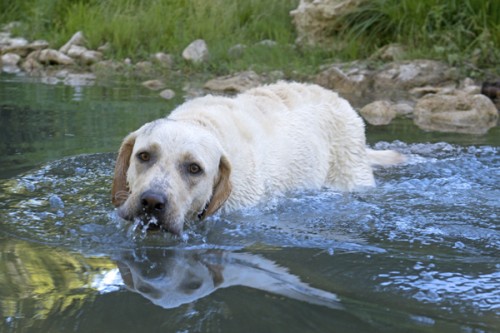
8 Dog Breeds Born to Swim
1. Chesapeake Bay Retriever
Chessies were developed as vigorous water retrievers, strong enough to swim in the cold, rough Chesapeake Bay, and retrieve a hundred birds per day. The Chessie has webbed feet to assist his Olympic-level swimming. Good luck tiring him out in the water throwing a ball.
2. Labrador Retriever
Predecessors of the Labrador Retriever worked with Newfoundland fisherman off the Labrador Sea shores. Renowned for energy in the water and out, the breed was further developed in England for hunting and retrieving. The powerful Lab has webbing between his toes and a strong otter-like tail for swimming. Odds are he’ll match his swimming talent with dock diving, if given the chance.
3. Newfoundland
The Newfoundland was bred to brave freezing cold waters as he worked with fishermen. Fantastic water rescue tales abound about the valiant Newfoundland. With his raw strength, webbed feet, and water resistant coat, the Newfoundland today can’t wait for the opportunity to take to the water. Hopefully his owner likes liquid of all sorts, given the Newfie’s famous drooling and slobbery kisses.
4. Portuguese Water Dog
Bred to accompany fisherman, Portuguese Water Dogs can dive as well as swim. Historically developed to dive for fish and retrieve nets, Portuguese Water Dogs also delivered messages between boats and guarded boats in port. Families today will find their Portuguese Water Dogs head straight into water when the opportunity presents. Getting the dog to come back to land may be more challenging.
5. Brittany
Developed to both point and retrieve, the Brittany became a popular gun dog in the early 20th century. His breed history lacks the swimming legacy of the water-retrievers, but he’s game for activity on both land and water. The Brittany has limitless energy, a wash-and-go coat, and — weighing in at about 30 pounds — he’ll hardly mess up your car after a swimming day.
6. Poodle
The Poodle breed name probably originates from the German Pudel, meaning “one who plays in water.” The famous Poodle clip in actuality was designed not for glamor, but to facilitate swimming. A Toy Poodle can swim too, but smaller dogs may tire over long distances.
7. Nova Scotia Duck Tolling Retriever
Bred to toll, lure, and retrieve waterfowl, water might as well be this breeds middle name. Hunters took note the behavior of wild foxes, who playfully lured waterfowl to the shore making them easy pray and trained these dogs to mimic the action. Believed to be related to the Chesapeake Bay Retriever and the Brittany it’s no surprise that this breed is such a graceful swimmer.
8. Australian Shepherd
Now it’s time to defend Cooper and Aussies everywhere. Bred as an all-around working dog, Aussies can swim. They don’t have webbed feet or a rudder-like tail (or much of a tail at all for that matter). Their swimming will certainly lack the finesse of other water breeds. After all, Aussies were bred to help ranchers and herd livestock. Nevertheless, the endlessly energetic Aussie will work and play anywhere, including in the water.
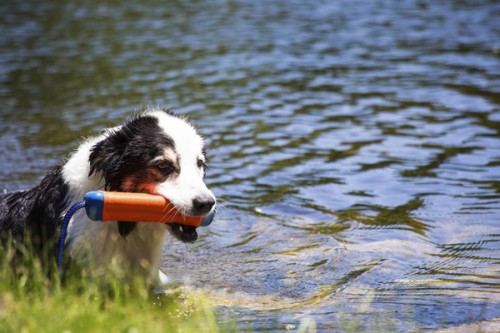
1. Bulldog
Dogs bred with heavy chests relative to their hindquarters aren’t designed for swimming. Given their body type, paddling to carry their weight can be daunting if not impossible. While many are known to surf and skateboard they are happier going along for the ride than rowing their own boat. Many enjoy sitting in a kiddie pool, but anything deeper than that, get them a raft and a life jacket.
2. French Bulldog
Like the Bulldog, Frenchies are not buoyant by nature. The Frenchie won’t likely care about his aquatic inadequacy; he was bred for companionship, not athletic adventures. Owners inclined to take a Frenchie near water should invest in a dog life jacket. More About French Bulldogs>>
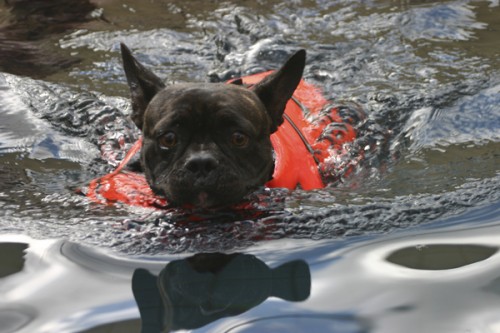
Due their unique size and shape, Bassets more closely resemble an anchor than a swimming dog. Swimming can be a difficult feat for the Basset Hound. The breeds short legs, heavy front-end and drooping skin, makes it hard for them to keep their heads above the water. While they need a life jacket for anything deep, they will enjoy cooling off in shallow water. Sprinklers are probably a bit more their speed.
4. Pug
A breed with roots to antiquity, the Pug in the Toy Group was bred for friendship, not to work for a living. A few Pugs may enjoy a casual dip in the water, but the breed’s short snout contributes to his lack of stamina. Owners must supervise closely and fit the lif ejacket on the Pug…snug.





